battery BUICK CENTURY 1996 Owners Manual
[x] Cancel search | Manufacturer: BUICK, Model Year: 1996, Model line: CENTURY, Model: BUICK CENTURY 1996Pages: 340, PDF Size: 17.61 MB
Page 12 of 340
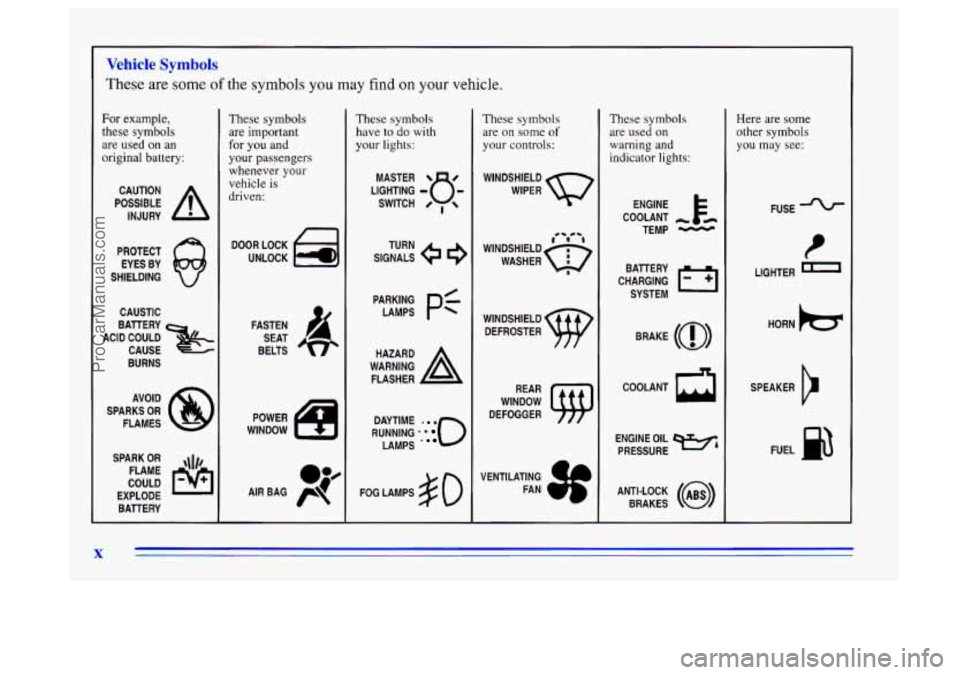
Vehicle Symbols
These are some of the symbols you may find on your vehicle.
For example,
these symbols
are used on an
original battery:
POSSIBLE A
CAUTION
INJURY
PROTECT EYES BY
SHIELDING
CAUSTIC
ACID COULD BATTERY
CAUSE
BURNS
SPARK
OR ,111,
COULD FLAME
EXPLODE BATTERY
These symbols
are important
for you and
your passengers
whenever your
vehicle is
driven:
DOOR LOCK
UNLOCK
POWER
WINDOW
These symbols have
to do with
your lights:
SIGNALS e e3
TURN
RUNNING
* ' 0
DAYTIME - a
LAMPS '
FOG LAMPS # 0
These symbols
are on some of
your controls:
WINDSHIELD
WIPER
WINDSHIELD DEFROSTER
VENTILATING FAN
These symbols are used on
warning and
indicator lights:
COOLANT
TEMP
-
CHARGING I-1
BATTERY
SYSTEM
BRAKE
(a)
COOLANT a
ENGINE OIL w,
PRESSURE
ANTI-LOCK
(@)
BRAKES
Here are some
other
symbols
you may see:
FUSE
P
LIGHTER
HORN
SPEAKER FUEL
p3
ProCarManuals.com
Page 37 of 340
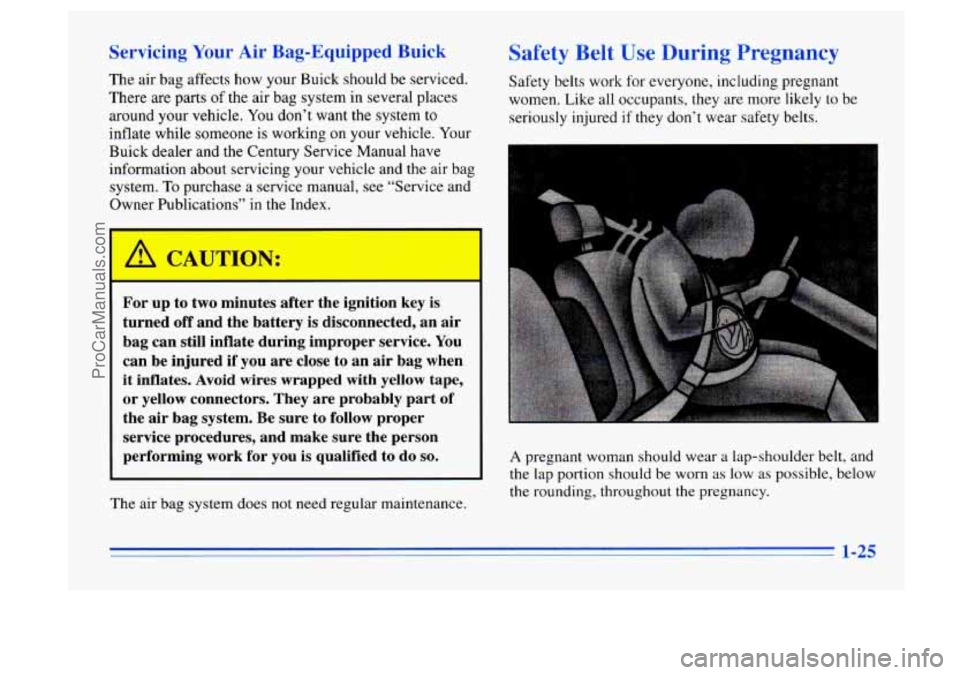
Servicing Your Air Bag-Equipped Buick
The air bag affects how your Buick should be serviced.
There are parts
of the air bag system in several places
around your vehicle. You don’t want the system
to
inflate while someone is working on your vehicle. Your
Buick dealer and the Century Service Manual have
information about servicing your vehicle and the air bag
system. To purchase a service manual,
see “Service and
Owner Publications” in the Index.
Safety Belt Use During Pregnancy
Safety belts work for everyone, including pregnant
women. Like all occupants, they are more
likely to be
seriously injured
if they don’t wear safety belts.
For up to two minutes after the ignition key is
turned
off and the battery is disconnected, an air
bag can still inflate during improper service.
You
can be injured if you are close to an air bag when
it inflates. Avoid wires wrapped with yellow tape,
or yellow connectors. They are probably part of
the air bag system. Be sure to follow proper
service procedures, and make sure the person
performing work for you is qualified to do
so.
The air bag system does not need regular maintenance.
A pregnant woman should wear a lap-shoulder belt, and
the
lap portion should be worn as low as possible, below
the rounding, throughout the pregnancy.
1-25
ProCarManuals.com
Page 63 of 340
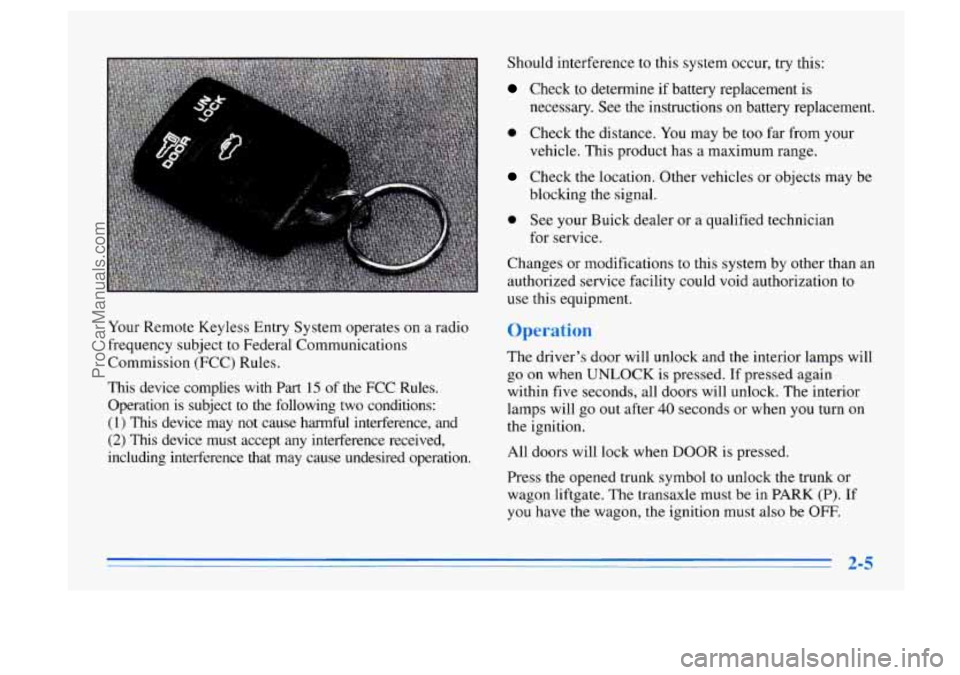
Should interference to this system occur, try this:
Check to determine if battery replacement is
necessary. See the instructions on battery replacement.
vehicle. This product has a maximum range.
blocking the signal.
for service.
0 Check the distance. You may be too far from your
Check the location. Other vehicles or objects may be
0 See your Buick dealer or a qualified technician
Changes or modifications to this system by other than an
authorized service facility could void authorization to
use this equipment.
Your Remote Keyless Entry System operates
on a radio
frequency subject to Federal Communications
Commission (FCC) Rules.
This device complies with Part 15 of the FCC Rules.
Operation is subject to the following two conditions:
( 1) This device may not cause harmful interference, and
(2) This device must accept any interference received,
including interference that may cause undesired operation.
lperat
fhe drwer’s door will unlock and the interior lamps will
go on when UNLOCK is pressed. If pressed again
within five seconds, all doors will unlock. The interior
lamps will go
out after 40 seconds or when you turn on
the ignition.
All doors will lock when DOOR is pressed.
Press the opened trunk symbol
to unlock the trunk or
wagon liftgate. The transaxle must be in
PARK (P). If
you have the wagon, the ignition must also be OFF.
ProCarManuals.com
Page 64 of 340
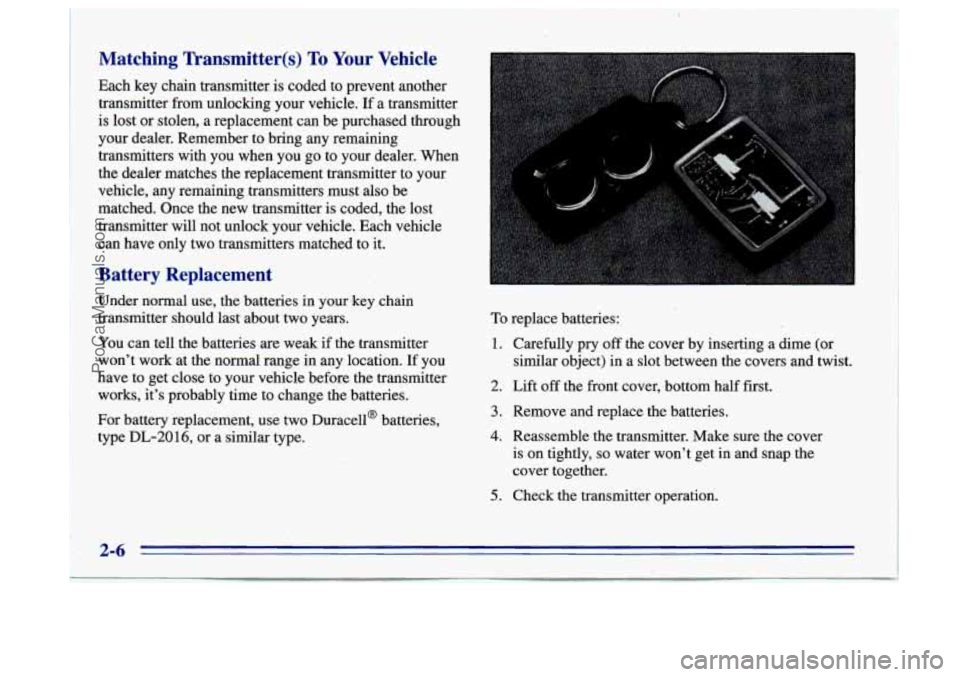
Matching Transmitter(s) To Your Vehicle
Each key chain transmitter. is coded to prevent another
transmitter from unlocking your vehicle. If a transmitter
is lost or stolen,
a replacement can be purchased through
your dealer. Remember to bring any remaining
transmitters with you when you go to your dealer. When
the dealer matches the replacement transmitter to your
vehicle, any remaining transmitters must also be
matched. Once the new transmitter is coded, the lost
transmitter will not unlock your vehicle. Each vehicle
can have
only two transmitters matched to it.
Battery Replacement
Under normal use, the batteries in your key chain
transmitter should last about two years.
You can tell the batteries are weak if the transmitter
won’t work at the normal range
in any location. If you
have to get close to your vehicle before the transmitter
works, it’s probably time
to change the batteries.
For battery replacement, use two Duracella batteries,
I-
To replace batteries:
1. Carefully pry off the cover by inserting a dime (or
2.
3.
4.
5.
similar object) in a slot between the covers and twist.
Lift
off the front cover, bottom half first.
Remove and replace the batteries. Reassemble the transmitter. Make sure the cover
is on tightly,
so water won’t get in and snap the
cover together.
Check the transmitter operation.
ProCarManuals.com
Page 70 of 340
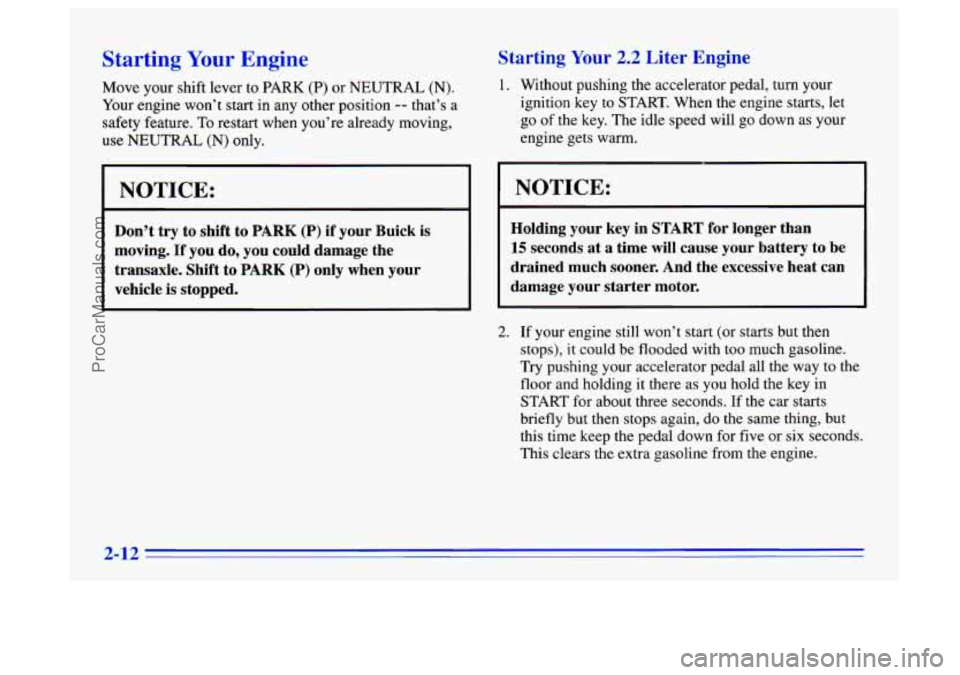
Starting Your Engine
Move your shift lever to PARK (P) or NEUTRAL (N).
Your engine won’t start in any other position -- that’s a
safety feature.
To restart when you’re already moving,
use NEUTRAL
(N) only.
I NOTICE:
Don’t try to shift to PARK (P) if your Buick is
moving.
If you do, you could damage the
transaxle. Shift to PARK
(P) only when your
vehicle is stopped.
Starting Your 2.2 Liter Engine
1. Without pushing the accelerator pedal, turn your
ignition key to START. When the engine starts,
let
go of the key. The idle speed will go down as your
engine gets warm.
NOTICE:
Holding your key in START for longer than
15 seconds at a time will cause your battery to be
drained much sooner. And the excessive heat can
damage your starter motor.
2. If your engine still won’t start (or starts but then
stops), it could be flooded with
too much gasoline.
Try pushing your accelerator pedal all the way
to the
floor and holding it there
as you hold the key in
START for about three seconds. If the car starts
briefly but then stops again,
do the same thing, but
this time keep the pedal down for five or six seconds.
This clears the extra gasoline from the engine.
2-12
ProCarManuals.com
Page 71 of 340
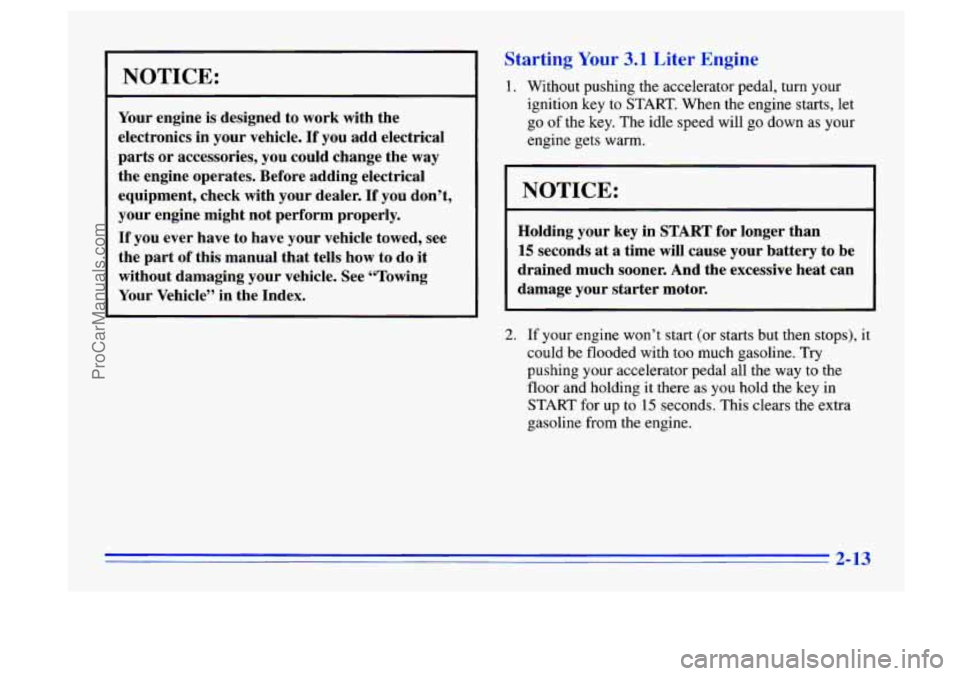
NOTICE:
Your engine is designed to work with the
electronics
in your vehicle. If you add electrical
parts or accessories, you could change the way
the engine operates. Before adding electrical
equipment, check with your dealer.
If you don’t,
your engine might not perform properly.
If you ever have to have your vehicle towed, see
the part of this manual that tells how to do it
without damaging your vehicle. See “Towing
Your Vehicle” in the Index.
Starting Your 3.1 Liter Engine
1. Without pushing the accelerator pedal, turn your
ignition key to START. When the engine starts, let
go of the key. The idle speed will go down as your
engine gets warm.
NOTICE:
Holding your key in START for longer than
15 seconds at a time will cause your battery to be
drained much sooner. And the excessive heat can
damage your starter motor.
2. If your engine won’t start (or starts but then stops), it
could be flooded with too much gasoline. Try
pushing your accelerator pedal all the way
to the
floor and holding
it there as you hold the key in
START for up
to 15 seconds. This clears the extra
gasoline from the engine.
2-13
ProCarManuals.com
Page 108 of 340
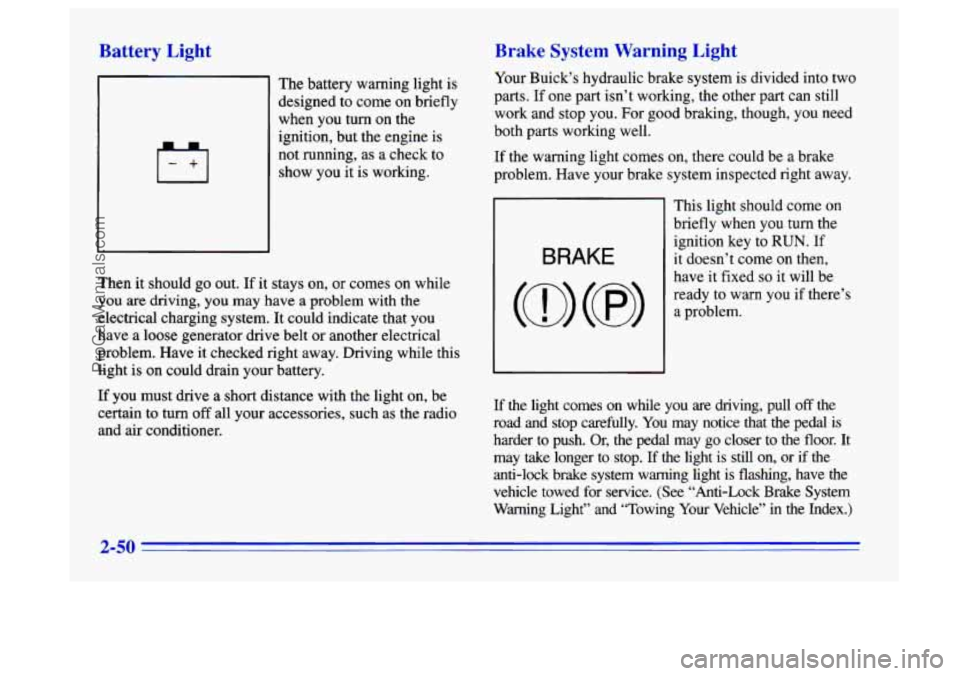
Battery Light
I-+I
The battery warning light is
designed to come on briefly
when you turn on the
ignition, but the engine is
not running, as
a check to
show you it is working.
Then it should go out.
If it stays on, or comes on while
you
are driving, you may have a problem with the
electrical charging system. It could indicate that you
have a loose generator drive belt or another electrical
problem. Have it checked right away. Driving while this
light is on could drain your battery.
If
you must drive a short distance with the light on, be
certain to turn
off all your accessories, such as the radio
and air conditioner.
Brake System Warning Light
Your Buick’s hydraulic brake system is divided into two
parts.
If one part isn’t working, the other part can still
work and stop you. For good braking, though, you need
both parts working well.
If the warning light comes on, there could be a brake
problem. Have your brake system inspected right
away.
BRAKE
This light should come on
briefly when you turn the
ignition key to
RUN. If
it doesn’t come on then,
have it fixed
so it will be
ready to warn you if there’s
a problem.
If the light comes on while you
are driving, pull off the
road and stop carefully. You may notice that
the pedal is
harder to push. Or, the pedal may
go closer to the floor. It
may take longer to stop.
If the light is still on, or if the
anti-lock brake system warning light is flashing, have the
vehicle towed for service.
(See “Anti-Lock Brake System
Warning Light” and ‘Towing Your Vehicle” in the Index.)
2-50
ProCarManuals.com
Page 157 of 340
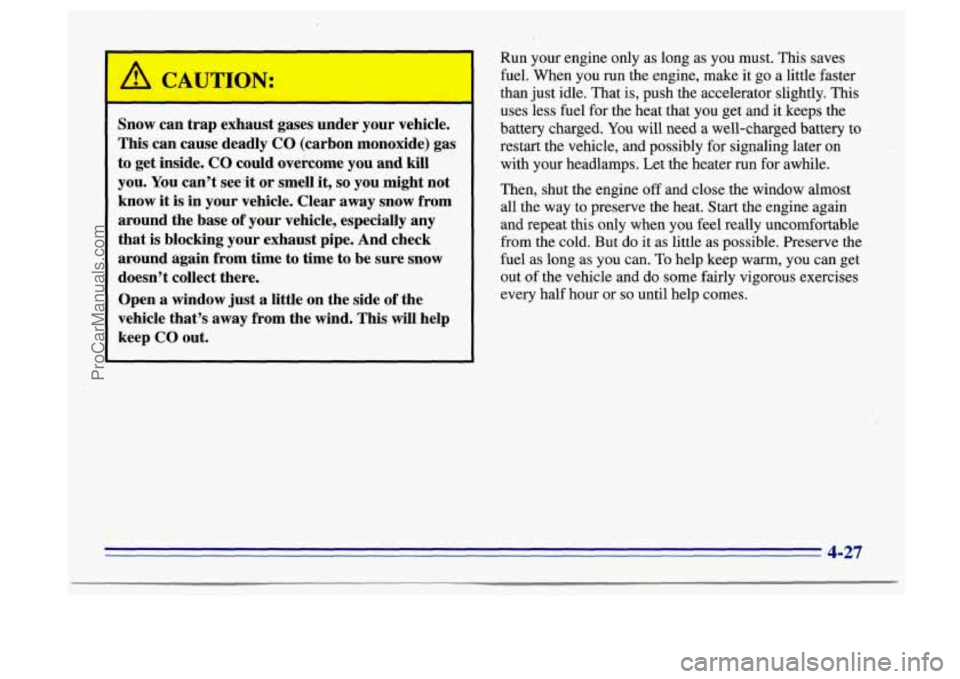
Snow can trap exhaust gases under your vehicle.
This can cause deadly CO (carbon monoxide) gas
to get inside. CO could overcome you and kill
you. You can’t see !it or smell it,
so you might not
know it
is in your vehicle. Clear away snow from
around the base of your vehicle, especially any
that is blocking ‘your exhaust pipe. And check
around again from time
to time to be sure snow
doesn’t collect there.
Open a window just a little on the side of the
vehicle that’s away from the wind.
This will help
keep
CO out.
Run your erigine only as long as you must. This saves
fuel. When you run the engine, make it go a little faster
than just idle. That is, push the accelerator slightly.
This
uses less fuel for the heat that you get and it keeps the
battery charged. You will need a well-charged battery
to
restart the vehicle, and possibly for signaling later on
with your headlamps. Let the heater run for awhile.
Then, shut the engine
off and close the window almost
all the way to preserve the heat. Start the engine again
and repeat this
only when you feel really uncomfortable
from the cold. But
do it as little as possible. Preserve the
fuel as long as you can.
To help keep warm, you can get
out of the vehicle and do some fairly vigorous exercises
every half hour
or so until help comes.
ProCarManuals.com
Page 168 of 340
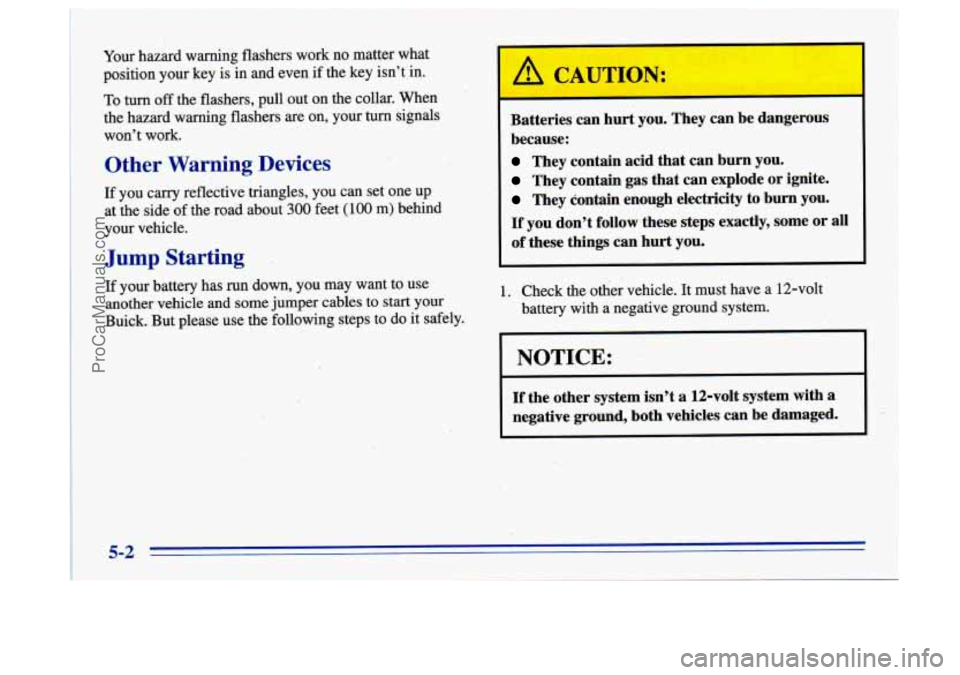
Your hazard warning flashers work no matter what
position your key is in and even if the key isn’t in.
To turn off the flashers, pull out on the collar. When
the hazard warning flashers are on, your
turn signals
won’t work.
Other Warning Devices
~f you carry reflective triangles, you can set one up
at the side of the road about
300 feet (100 m) behind
your vehicle.
Jump Starting
If your battery has run down, you may want to use
another vehicle and
some jumper cables to start your
Buick. But please use the following steps to do
it safely.
A CAUTION:
Batteries can hurt you. They can be dangerous
because:
They contain acid that can burn you.
They contain gas that can explode or ignite.
They contain enough electricity to burn you.
If you don’t follow these steps exactly, some
or all
of these things can hurt you.
1. Check the other vehicle. It must have a 12-volt
battery with a negative ground system.
ProCarManuals.com
Page 169 of 340
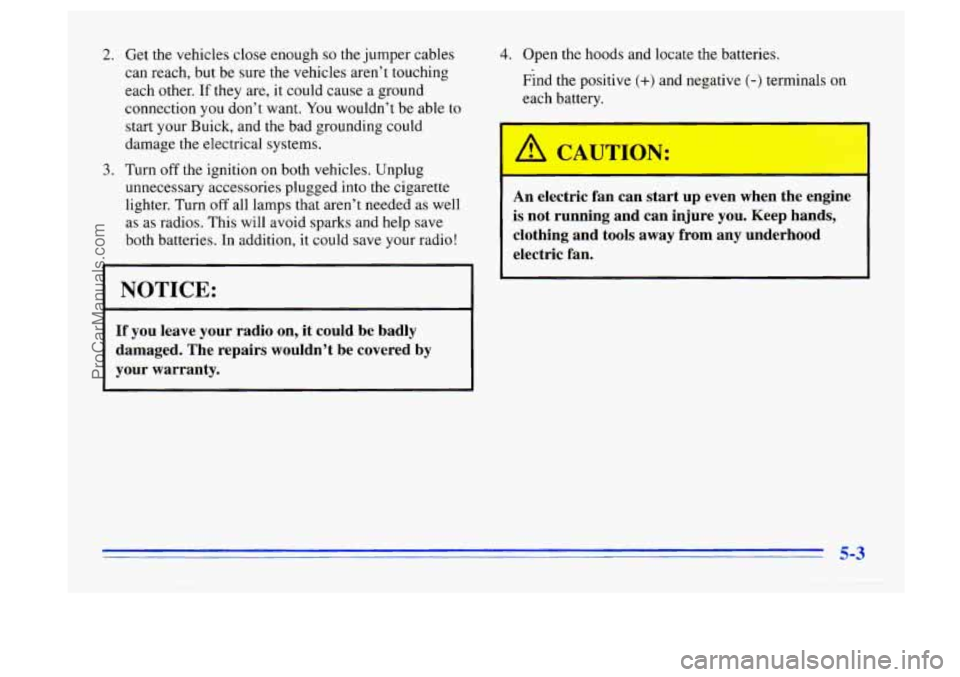
2.
3.
Get the vehicles close enough so the jumper cables
can reach, but be sure the vehicles aren’t touching
each other.
If they are, it could cause a ground
connection you don’t want. You wouldn’t be able to
start your Buick, and the bad grounding could
damage the electrical systems.
Turn
off the ignition on both vehicles. Unplug
unnecessary accessories plugged into the cigarette
lighter. Turn
off all lamps that aren’t needed as well
as as radios. This will avoid sparks and help save
both batteries. In addition, it could save your radio!
NOTICE:
If you leave your radio on, it could be badly
damaged. The repairs wouldn’t be covered by
your warranty.
4. Open the hoods and locate the batteries.
Find the positive
(+) and negative (-) terminals on
each battery.
A
I CAUTION:
An electric fan can start up even when the engine
is not running and can injure you. Keep hands, clothing and tools away from any underhood
electric fan.
5-3
ProCarManuals.com